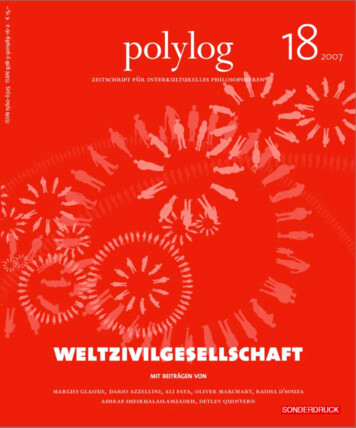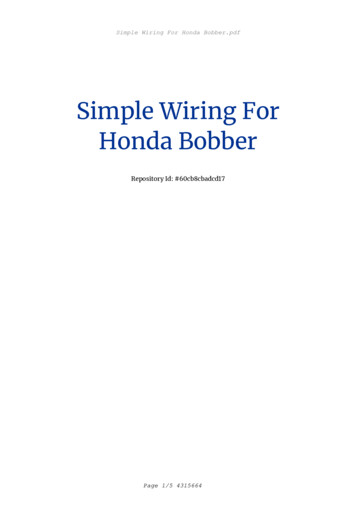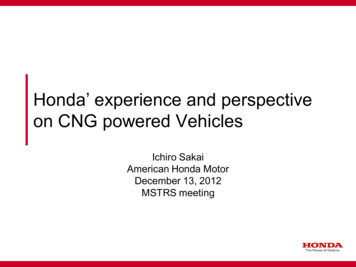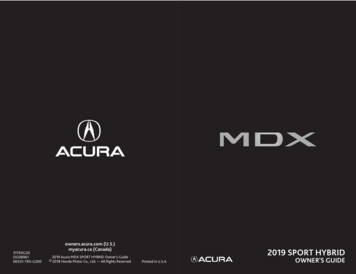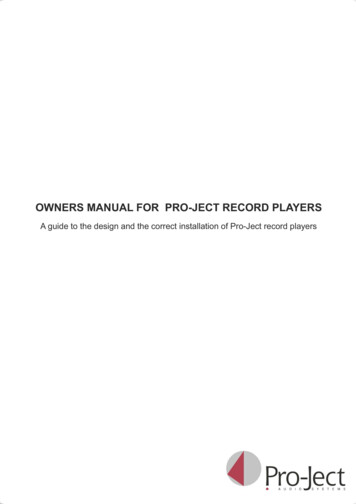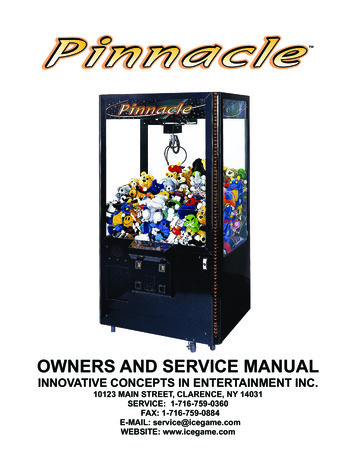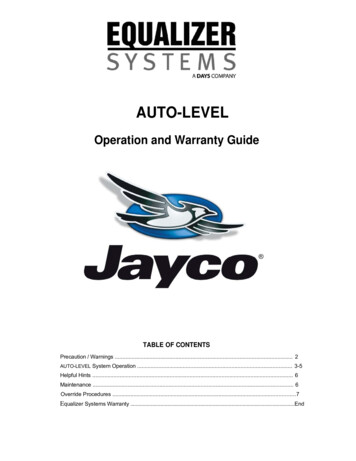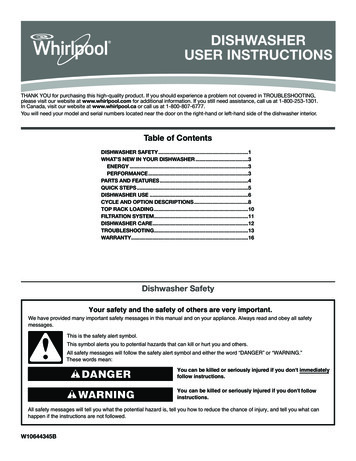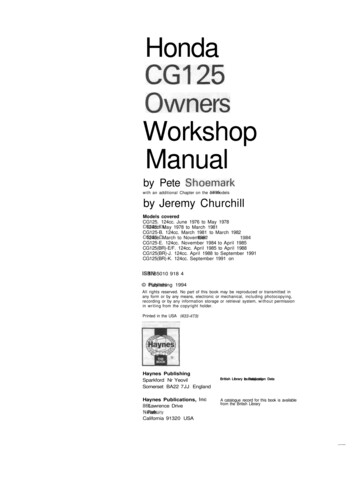
Transcription
HondaCG125OwnersWorkshopManualby Pete Shoemarkwith an additional Chapter on the 1985 on modelsby Jeremy ChurchillModels coveredCG125. 124cc. June 1976 to May 1978CG125K1. 124cc. May 1978 to March 1981CG125-B. 124cc. March 1981 to March 1982CG125-C. 124cc. March 1982 to November 1984CG125-E. 124cc. November 1984 to April 1985CG125(BR)-E/F. 124cc. April 1985 to April 1988CG125(BR)-J. 124cc. April 1988 to September 1991CG125(BR)-K. 124cc. September 1991 onISBN 1 85010 918 4 Haynes Publishing 1994All rights reserved. No part of this book may be reproduced or transmitted inany form or by any means, electronic or mechanical, including photocopying,recording or by any information storage or retrieval system, without permissionin writing from the copyright holder.Printed in the USA (433-4T9)Haynes PublishingSparkford Nr YeovilSomerset BA22 7JJ EnglandHaynes Publications, Inc861 Lawrence DriveNewbury ParkCalifornia 91320 USABritish Library CataloGuing in Publication DataA catalogue record for this book is availablefrom the British Library
AcknowledgementsOur thanks are due to APS Motorcycles of Wells (formerlyFran Ridewood & Co), Paul Branson Motorcycles of Yeovil, andCSM of Taunton, who supplied the machines featured in thismanual.We would also like to thank the Avon Rubber Company, whokindly supplied information and technical assistance on tyrefitting; NGK Spark Plugs (UK) Ltd for information on spark plugmaintenance and electrode conditions and Renold Limited foradvice on chain care and renewal.About this manualThe author of this manual has the conviction that the onlyway in which a meaningful and easy to follow text can bewritten is first to do the work himself, under conditions similarto those found in the average household. As a result, the handsseen in the photographs are those of the author. Even themachines are not new: examples that have covered a considerable mileage were selected so that the conditions encounteredwould be typical of those found by the average owner.Unless specially mentioned, and therefore consideredessential, Honda service tools have not been used. There isinvariably some alternative means of slackening or removingsome vital component when service tools are not available andrisk of damage has to be avoided at all costs.Each of the six Chapters is divided into numbered Sections.Within the Sections are numbered paragraphs. In consequence,cross reference throughout this manual is both straightforwardand logical. When a reference is made 'See Section 5.12' itmeans Section 5, paragraph 12 in the same Chapter. If anotherChapter were meant, the text would read 'See Chapter 2,Section 5.12'. All photographs are captioned with aSection/paragraph number to which they refer and are alwaysrelevant to the Chapter text adjacent.Figure numbers (usually line illustrations) appear innumerical order, within a given Chapter. Fig. 1.1 therefore refersto the first figure in Chapter 1. Left-hand and right-handdescriptions of the machines and their component parts refer tothe right and left of a given machine when the rider is seatednormally.Motorcycle manufacturers continually make changes tospecifications and recommendations, and these, when notified,are incorporated into our manuals at the earliest opportunity.We take great pride in the accuracy of information given inthis manual, but motorcycle manufacturers make alterations anddesign changes during the production run of a particularmotorcycle of which they do not inform us. No liability can beaccepted by the authors or publishers for loss, damage or injurycaused by any errors in, or omissions from, the information given.
ContentsPageAcknowledgements2About this manual2Introduction to the Honda CG1255Model dimensions and weight5Ordering spare parts6Safety first!7Routine maintenance8Quick glance maintenance adjustments and capacities13Recommended lubricants13Working conditions and tools/Chapter 1 Engine, clutch and gearbox15Chapter 2 Fuel system and lubrication52Chapter 3 Ignition system60Chapter 4 Frame and forks67Chapter 5 Wheels, brakes and tyres80Chapter 6 Electrical system93Chapter 7 The 1985 on modelsWiring diagrams107103, 124Conversion factors125Index126I
The Honda CG125 modelThe Honda CG125-C model
Introduction to the Honda CG125The CG125 model first appeared in the UK in June 1976. Itcan be regarded in many ways as a utility version of the popularCB1 25 with which it shares many features. The basic differencebetween the two models is the CG125's use of pushrodoperated overhead valves in place of the more popular overheadcamshaft arrangement. The unit provides surprisingly briskperformance coupled with good fuel economy. The machine ingeneral is functional and sensibly equipped, and does not sufferthe surfeit of gadgetry so often found on its contemporaries. Itsinherent simplicity makes it an ideal learner's or commuter'smount, both in terms of ease of riding and in its ease ofmaintenance. A noteworthy feature is the adoption of a full rearchain enclosure. Although this is by no means a new idea,having appeared and disappeared many times over the yearswith the changing dictates of fashion, it is, nevertheless, aneminently sensible feature, greatly extending chain life.Despite remaining basically unchanged, the CG125 hasreceived several modifications and has been altered slightly inappearance to keep up with its rivals. Five distinct versions haveappeared, with differences of varying significance, which areidentified (where applicable) in this Manual by their Hondamodel code suffixes. Identification details, as available, aregiven below with the approximate dates of import; note that thelatter need not necessarily coincide with the machine's date ofregistration.The CG125 model (no identifying suffix) has the framenumbers CG125-1023061 to 1111090. Engine numbers arenot available. Identified by its shrouded, external spring, frontforks, this model Was imported from June 1976 to May 1978.The C G 1 2 5 K 1 model has the frame numbersCG125-1114636 to 1162518. Engine numbers not available.It differed most noticeably from the CG125 model in havingfront forks with internal springs and exposed stanchions, andwas imported from May 1978 to March 1981.The CG125-B model has the frame numbersCG125-1202755 to 1223689; its engine numbers start atCG125E-1374586. It can be distinguished from the K1 modelonly by its different paintwork and graphics and was importedfrom March 1981 to March 1982.The CG125-C model has the frame numbersCG125-1272831 to 1286692; its engine numbers start atCG125E-1513928 on. Fitted with revised tail lamp, flashingindicator lamps, handlebar switches and the usual detailchanges to paintwork and graphics. This model is also fittedwith a higher compression engine and the (T)PFC carburettorfor greater fuel economy. Note also that the ignition switch iscombined in a new warning lamp cluster, mounted next to thespeedometer. Imported from March 1982 to November 1984.The CG125-E model has the frame numberCG 125-1288790 to 1293380 and the engine numbersCG125E-1689761 to 1694851. Identical to the C modelexcept for detail changes to the graphics, this model wasimported from November 1984 to April 1985.All the aforementioned models are of Japanesemanufacture and are covered in Chapters 1 to 6. Later modelswere manufactured in Brazil and known as the CG125(BR)models; refer to Chapter 7 for further information.Model dimensions and weightOverall length1840 m m (72.4 in)Overall width735 m m (28.9 in)Overall height1025 m m (40.4 in)Wheelbase1200 m m (47.2 in)Seat height755 m m (29.7 in)Ground clearance135 m m (5.3 in)Dry weight95 kg (209 Ib)
*Ordering spare partsWhen ordering spare parts for the CG125 models, it isadvisable to deal direct with an official Honda agent, who willbe able to supply many of the items required ex-stock. It isadvisable to get acquainted with the local Honda agent, and torely on his advice when purchasing spares. He is in a betterposition to specify exactly the parts required and to identify therelevant spare part numbers so that there is less chance of thewrong part being supplied by the manufacturer due to a vagueor incomplete description.When ordering spares, always quote the frame and enginenumbers in full, together with any prefixes or suffixes in theform of letters. The frame number is found stamped on theright-hand side of the steering head, in line with the forks. Theengine number is stamped on the left-hand side of thecrankcase, immediately behind the oil strainer cap.Use only parts of genuine Honda manufacture. A fewpattern parts are available, sometimes at a cheaper price, butthere is no guarantee that they will give such good service asthe originals they replace. Retain any worn or broken parts untilthe replacements have been obtained; they are sometimesneeded as a pattern to help identify the correct replacementwhen design changes have been made during a production run.Some of the more expendable parts such as spark plugs,bulbs, tyres, oils and greases etc., can be obtained fromaccessory shops and motor factors, who have convenientopening hours and can often be found not far from home. It isalso possible to obtain them on a Mail Order basis from anumber of specialists who advertise regularly in the motorcyclemagazines.Frame number locationEngine number location
Safety first!Professional motor mechanics are trained in safe workingprocedures. However enthusiastic you may be about getting onwith the job in hand, do take the time to ensure that your safetyis not put at risk. A moments lack of attention can result in anaccident, as can failure to observe certain elementaryprecautions.There will always be new ways of having accidents, and thefollowing points do not pretend to be a comprehensive list of alldangers; they are intended rather to make you aware of therisks and to encourage a safety-conscious approach to all workyou carry out on your vehicle.Essential DOs and DON'TsDON'T start the engine without first ascertaining that thetransmission is in neutral.DON'T suddenly remove the filler cap from a hot coolingsystem - cover it with a cloth and release the pressure graduallyfirst, or you may get scalded by escaping coolant.DON'T attempt to drain oil until you are sure it has cooledsufficiently to avoid scalding you.DON'T grasp any part of the engine, exhaust or silencer withoutfirst ascertaining that it is sufficiently cool to avoid burning you.DON'T allow brake fluid or antifreeze to contact the machine'spaintwork or plastic components.DON'T syphon toxic liquids such as fuel, brake fluid orantifreeze by mouth, or allow them to remain on your skin.DON'T inhale dust - it may be injurious to health (see Asbestosheading).DON'T allow any spilt oil or grease to remain on the floor —wipe it up straight away, before someone slips on it.DON'T use ill-fitting spanners or other tools which may slip andcause injury.DON'T attempt to lift a heavy component which may bebeyond your capability - get assistance.DON'T rush to finish a job, or take unverified short cuts.DON'T allow children or animals in or around an unattendedvehicle.DON'T inflate a tyre to a pressure above the recommendedmaximum. Apart from overstressing the carcase and wheel rim,in extreme cases the tyre may blow off forcibly.DO ensure that the machine is supported securely at all times.This is especially important when the machine is blocked up toaid wheel or fork removal.DO take care when attempting to slacken a stubborn nut orbolt. It is generally better to pull on a spanner, rather than push,so that if slippage occurs you fall away from the machine ratherthan on to it.DO wear eye protection when using power tools such as drill,sander, bench grinder etc.DO use a barrier cream on your hands prior to undertaking dirtyjobs — it will protect your skin from infection as well as makingthe dirt easier to remove afterwards; but make sure your handsaren't left slippery. Note that long-term contact with usedengine oil can be a health hazard.DO keep loose clothing (cuffs, tie etc) and long hair well out ofthe way of moving mechanical parts.DO remove rings, wristwatch etc, before working on the vehicle- especially the electrical system.DO keep your work area tidy - it is only too easy to fall overarticles left lying around.DO exercise caution when compressing springs for removal orinstallation. Ensure that the tension is applied and released in acontrolled manner, using suitable tools which preclude thepossibility of the spring escaping violently.DO ensure that any lifting tackle used has a safe working loadrating adequate for the job.DO get someone to check periodically that all is well, whenworking alone on the vehicle.DO carry out work in a logical sequence and check thateverything is correctly assembled and tightened afterwards.DO remember that your vehicle's safety affects that of yourselfand others. If in doubt on any point, get specialist advice.IF, in spite of following these precautions, you are unfortunateenough to injure yourself, seek medical attention as soon aspossible.AsbestosCertain friction, insulating, sealing, and other products such as brake linings, clutch linings, gaskets, etc - containasbestos. Extreme care must be taken to avoid inhalation ofdust from such products since it is hazardous to health. If indoubt, assume that they do contain asbestos.FireRemember at all times that petrol (gasoline) is highlyflammable. Never smoke, or have any kind of naked flamearound, when working on the vehicle. But the risk does not endthere - a spark caused by an electrical short-circuit, by twometal surfaces contacting each other, by careless use of tools,or even by static electricity built up in your body under certainconditions, can ignite petrol vapour, which in a confined spaceis highly explosive.Always disconnect the battery earth (ground) terminalbefore working on any part of the fuel or electrical system, andnever risk spilling fuel on to a hot engine or exhaust
125 126 I. The Honda CG125 model The Honda CG125-C model. Introduction to the Honda CG125 The CG125 model first appeared in the UK in June 1976. It can be regarded in many ways as a utility version of the popular CB1 25 with which it shares many features. The basic difference between the two models is the CG125's use of pushrod operated overhead valves in place of the more popular
